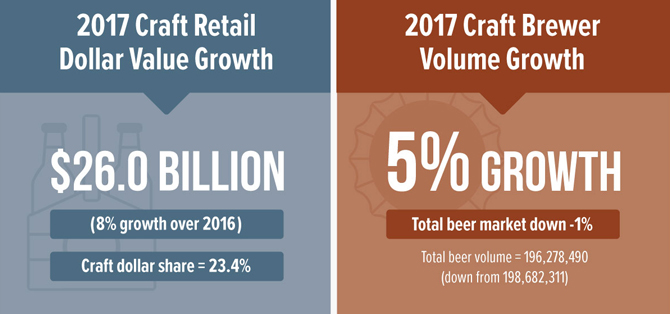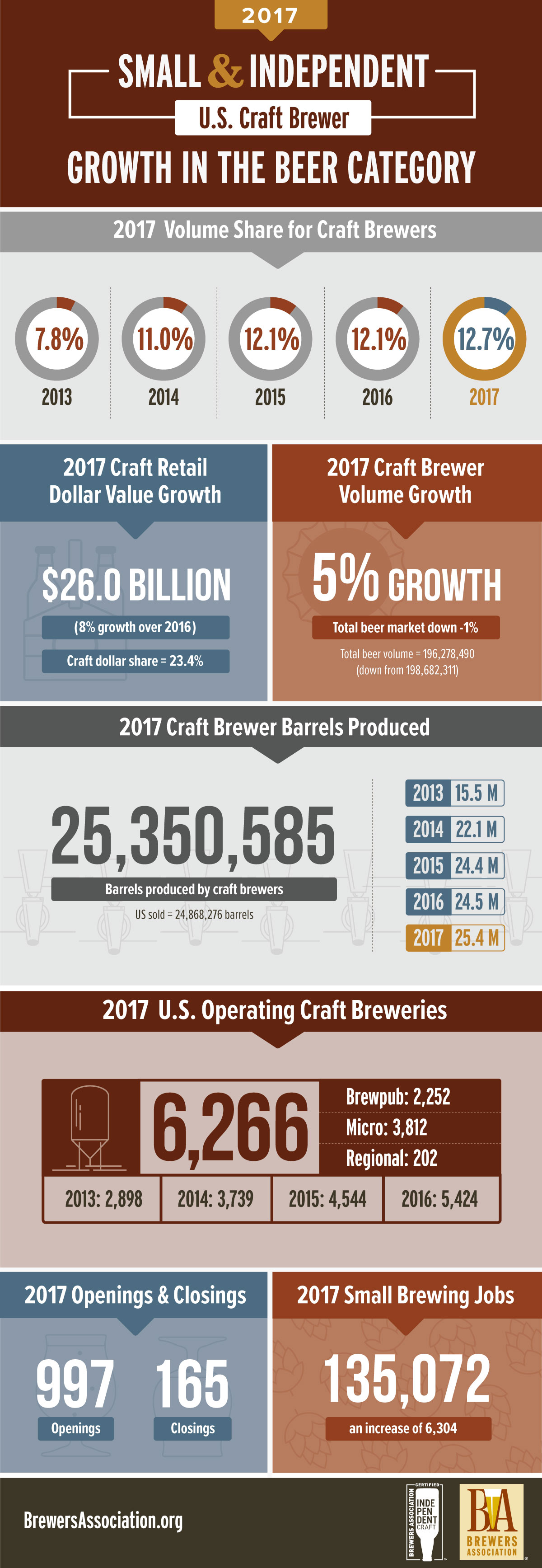
A record number of breweries opened their doors last year, according to a new report from industry trade group the Brewers Association (BA).
The BA, which represents the interests of small and independent American brewers, estimates that 997 breweries opened in 2017, bringing the total number of U.S. breweries to 6,372.
At the same time, however, the number of breweries that closed in last year increased by 70 percent, to 165.
Bart Watson, chief economist for the Colorado-headquartered association, said he expects both figures to grow as the organization adjusts its numbers to more accurately reflect the number of small brewing companies currently operating in the U.S. marketplace.
“I would expect that number to eclipse 1,000,” he said of brewery openings, noting that the organization missed 167 new breweries when it released its 2016 numbers last March.
Despite the uptick in brewery closures – 97 shuttered in 2016 — a staggering 4,256 breweries have launched over the last five years, according to BA data. There’s also about 2,500 more in planning, Watson said.

During that same period, however, 483 breweries went out of business (about one-third of those companies closed in 2017).
In a teleconference call with members of the press, Watson pointed to increased competition for the growing number of brewery closures.
“It is a competitive marketplace, and I think we will see the brewery closure number continue to rise,” he said. “Part of it is that we just see an increase in the number of breweries, so even if the rate of closures had stayed constant, you would expect the number of closures to go up.”
Approximately 2.6 percent of all U.S. craft breweries closed last year, Watson added, noting that the increase was a “natural function of a maturing industry.”
“One thing that people in the craft industry need to recognize is that an era where no one closed is the anomaly,” he said, adding that more competitive pockets of the U.S. could see a higher number of closures in the future.
“The idea that every business is going to be successful is just not something that was going to be sustainable in the long run,” he added.
Still, the “vast majority” of closures are due to “things that affect any small business,” Watson said, calling out rent and landlord issues as two reasons why some companies closed in 2017.
Nevertheless, 6,266 of the breweries in the U.S. that meet the BA’s “craft brewer” definition — which stipulates that companies produce fewer than 6 million barrels of “traditional” beer annually, and be less than 25 percent owned by a company that is not itself a craft brewer – collectively grew to nearly 25.4 million barrels.
Together, those companies represent about 12.7 percent of all beer sold in the U.S. and 23.4 percent of retail dollars (estimated at $26 billion).

Those figures would be higher, however, if companies such as Goose Island, Lagunitas Brewing, Founders Brewing and Ballast Point — among many others who sold to larger companies and no longer meet the BA definition — were still counted in the data set, Watson said when asked why he believed craft breweries would fall short of a 2014 goal to reach 20 percent market share by 2020.
“The biggest reason is acquisitions,” he said. “The share that independent brewers have has gone down in an era where many of the fastest-growing regional craft breweries were acquired by large breweries. If we added those breweries’ volumes back in, I think it would still be a challenge, but it is something that the brewers in the data set when that goal was formulated could have met by 2020.”
Meanwhile, category-wide production only grew five percent in 2017, a slight downtick from six percent growth in 2016 and a significant slowdown from the six straight years of double-digit growth between 2010 and 2015.
The BA plans to release additional information regarding direct-to-consumer taproom sales tomorrow, Watson said. In the meantime, a press release and infographic with additional information is included below.

Small and Independent Brewers See Sustained Growth in 2017
Boulder, Colo • March 27, 2018 — The Brewers Association (BA)—the trade association representing small and independent American craft brewers—today released 2017 data on U.S. craft brewing growth. With over 6,300 breweries operating during the year, small and independent craft brewers represent 12.7 percent market share by volume of the overall beer industry.
In 2017, craft brewers produced 25.4 million barrels, and saw a 5 percent rise in volume on a comparable base and an 8 percent increase in retail dollar value. Retail dollar value was estimated at 26.0 billion, representing 23.4 percent market share. Microbreweries and brewpubs delivered 76 percent of the craft brewer growth. Craft brewing’s growth occurred in the context of a total beer market which dropped 1 percent by volume in 2017.
“Growth for the craft brewing industry is adapting to the new realities of a mature market landscape,” said Bart Watson, chief economist, Brewers Association. “Beer lovers are trending toward supporting their local small and independent community craft breweries. At the same time, as distribution channels experience increased competition and challenges, craft brewer performance was more mixed than in recent years, with those relying on the broadest distribution facing the most pressure.”
Additionally, in 2017 the number of operating breweries in the U.S. grew 16 percent, totaling 6,372 breweries, broken down as follows: 3,812 microbreweries, 2,252 brewpubs, 202 regional craft breweries and 106 large or otherwise non-craft brewers. Small and independent breweries account for 98 percent of the breweries in operation. Throughout the year, there were 997 new brewery openings and only 165 closings— a closing rate of just 2.6 percent. Combined with already existing and established breweries and brewpubs, craft brewers provided more than 135,000 jobs, an increase of greater than 6,000 from the previous year.
“Beer lovers want to support businesses that align with their values and are having a positive impact on their local communities and our larger society,” added Watson. “That’s what small and independent craft brewers are all about. The ability to seek beers from small and independent producers matters.”

To educate beer lovers about which beers are independently produced, the BA launched the certified independent seal in June 2017. More than 3,100 independent brewers have committed to adopting it.
Note: Numbers are preliminary. For additional insights from Bart Watson, visit “Behind the Data: 2017 Craft Brewing Growth Methodology” on the Brewers Association website. A more extensive analysis will be released during the Craft Brewers Conference & BrewExpo America® in Nashville, Tennessee from April 30 – May 3. The full 2017 industry analysis will be published in the May/June 2018 issue of The New Brewer, highlighting regional trends and production by individual breweries.
An American craft brewer is small, independent and traditional.
Small: Annual production of 6 million barrels of beer or less (approximately 3 percent of U.S. annual sales). Beer production is attributed to the rules of alternating proprietorships.
Independent: Less than 25 percent of the craft brewery is owned or controlled (or equivalent economic interest) by an alcoholic beverage industry member that is not itself a craft brewer.
Traditional: A brewer that has a majority of its total beverage alcohol volume in beers whose flavor derives from traditional or innovative brewing ingredients and their fermentation. Flavored malt beverages (FMBs) are not considered beers.
Absolute figures reflect the dynamic craft brewer data set as specified by the craft brewer definition. Growth numbers are presented on a comparable base. For full methodology, see the Brewers Association website.
Volume by craft brewers represent total taxable production.
About the Brewers Association
The Brewers Association (BA) is the not-for-profit trade association dedicated to small and independent American brewers, their beers and the community of brewing enthusiasts. The BA represents 4,000-plus U.S. breweries. The BA’s independent craft brewer seal is a widely adopted symbol that differentiates beers by small and independent craft brewers. The BA organizes events including the World Beer CupSM, Great American Beer Festival®, Craft Brewers Conference & BrewExpo America®, SAVOR℠: An American Craft Beer & Food Experience, Homebrew Con, National Homebrew Competition and American Craft Beer Week®. The BA publishes The New Brewer® magazine, and Brewers Publications® is the leading publisher of brewing literature in the U.S.
Beer lovers are invited to learn more about the dynamic world of craft beer at CraftBeer.com and about homebrewing via the BA’s American Homebrewers Association® and the free Brew Guru™ mobile app. Follow us on Facebook, Twitter and Instagram.
The Brewers Association is an equal opportunity employer and does not discriminate on the basis of race, color, national origin, gender, religion, age, disability, political beliefs, sexual orientation, or marital/familial status. The BA complies with provisions of Executive Order 11246 and the rules, regulations, and relevant orders of the Secretary of Labor.

